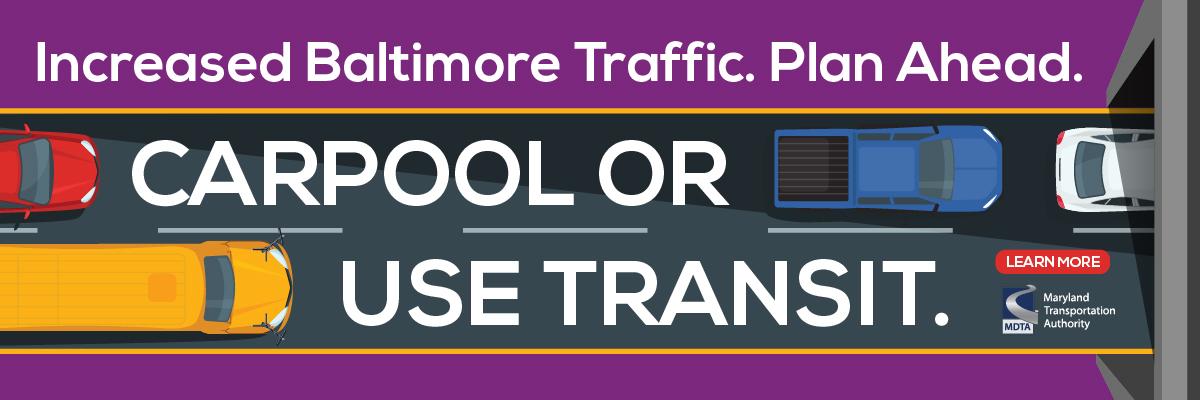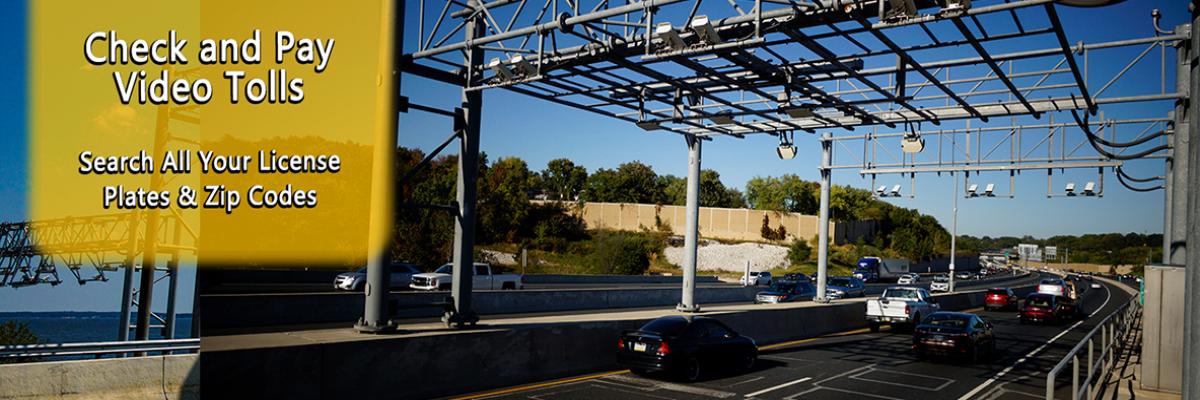
Baltimore Harbor Traffic Management Study
EXECUTIVE SUMMARY
The Maryland Transportation Authority (MDTA) owns, operates, and collects tolls for the three Baltimore Harbor crossings:
- I-95 / Fort McHenry Tunnel
- I-895 / Baltimore Harbor Tunnel
- I-695 / Francis Scott Key Bridge
In general, I-95 is used for access into downtown Baltimore and for traffic heading through/along the northeast corridor. I-895 is an alternate route for I-95; however, it is generally utilized more for local trips than for through traffic, based on the high E-ZPass® percentages and heavy weekday peak hours. I-695 is also used for more local trips and less frequently for through trips.
This study, which was completed in 2009, analyzed existing conditions on these three Baltimore Harbor crossing facilities and evaluated improvements to better distribute the traffic across them during the peak and off-peak times on the weekdays and weekends along the following roadway limits:
- I-95 from the I-95 / I-895 Split south of Baltimore to the I-95 / I-895 interchange on the north side of the city - 17 miles.
- I-895 in its entirety, from the I-95 / I-895 Split south of Baltimore to the I-95 / I-895 Split interchange on the north side of the city - 15 miles.
- I-695 on the southeast side of the city, from the I-95 / I-695 interchange south of Baltimore to the I-95 / I-695 interchange north of Baltimore - 24 miles.
Due to the scale of the study, the effort was separated into two phases. Phase 1 was a brainstorming and overview effort to identify the potential opportunities to better distribute the traffic across the MDTA's three harbor crossings. Phase 2 then evaluated these opportunities and improvements in greater detail with a focus on traffic modeling, short-term improvements, long-term improvements, and toll related operational changes. The traffic modeling effort was a tool used throughout the study to evaluate whether the improvements would meet the purpose of the study.
In summary, the results of the evaluation did not provide clear evidence that the improvements studied would meet the study purpose of better distributing the traffic across I-95, I-895, and I-695. Nevertheless, some of the improvements do have merit and could be considered by the MDTA to improve the facilities. Therefore, the following conclusions and recommendations were offered.
A. SHORT-TERM IMPROVEMENTS
The following short-term improvements were considered, along with the associated recommendations or conclusions:
- Static guide signs: To better inform motorists of the route choices available through Baltimore, additional or improved signing could be provided for I-895 and I-695 along northbound I-95, which conveys that either route could be used as an alternative to travel through Baltimore.
- Dynamic message signs: The DMS system could be enhanced by expanding and/or modifying the DMSs in advance of and along I-95 Northbound, I-895 Southbound, and I-895 Northbound, to assist in providing real-time travel time information to the motorist. The report provides recommendations for DMSs that include provision of additional signs at critical decision points along I-95 and I-895. This information could provide some incentive for motorists to consider alternate routes as needed.
A static plus dynamic Toll Congestion Delay (TCD) sign, could be placed along I-95 prior to the I-95/I-895 split and prior to the I-695 interchange both north and south of Baltimore City. This sign could be provided along I-695 Outer Loop and Inner Loop prior to the I-95 interchange as well.
Since dynamic travel time messages appear to be most effective when there is a clear origin and destination for the corridor, a target audience should be identified for the messages, such as providing times through the city for each route or providing times into downtown.
- Truck restrictions: Truck traffic traveling through the harbor crossings must choose their route based on their type of cargo, type of trailer, height/weight restrictions, and destination (through the city, Baltimore Port terminals, etc.). Therefore, there is little ability or benefit to restrict trucks for traffic operations purposes because the physical restrictions already pre-determine the route selection for many trucks. Additionally, there is little benefit to shifting trucks from I-95 and I-895 to I-695 if they are destined for the port terminals because there is not convenient access to the terminals from I-695.
B. LONG-TERM IMPROVEMENTS
The following long-term improvements and recommendations were presented:
- Adding new ramp movements or new interchanges on I-895: Although the new ramp improvements did not specifically meet the purpose of the project; they could still provide some benefit to the MDTA and/or the traveling public by improving traffic flow through the Baltimore Metropolitan area by shifting traffic from I-95 to I-895 or shifting traffic from local roads to I-895. However, these improvements would likely be considered only with implementation of mileage-based tolling along I-895. New ramps or modifications to existing ramps are offered for the following interchanges:
- Higher Priority: MD 2 / Potee Street, US 40, and I-95 / I-895 South.
- Average Priority: MD 648, I-695, and MD 295.
- Low Priority: I-195 and Holabird/Ponca/O'Donnell.
- Widening the mainline through congested areas on I-95 and I-695: It is not recommended that the MDTA continue to evaluate the localized mainline widening along I-95 and I-695 because it is not anticipated to improve the overall system operations nor better distribute the traffic across the three harbor crossings. Additionally, a significant portion of these facilities are owned and operated by the State Highway Administration; therefore, they would be the agency responsible for performing a more detailed study to address the congestion.
- Adjusting the horizontal geometry on I-695: It is not recommended that the MDTA continue to evaluate the alternatives that modified the horizontal curves south of MD 702 (Exit #36) because of the anticipated costs and impacts to BGE transmission towers, the existing I-695 bridges over Chesaco Avenue, and private property.
C. TOLL-RELATED IMPROVEMENTS
The following toll-related improvements and recommendations were presented:
- Variable pricing for the harbor crossings: The MDTA could consider a 20 percent off-peak discount in the toll rate for all vehicles (whether cash or E-ZPass) to achieve some traffic diversion to off-peak period. The MDTA could also consider a 20 percent E-ZPass discount on top of the off-peak period rates. The MDTA could consider a 50 percent discount in toll rates for trucks on weekday overnight hours i.e., 12AM to 6AM. In all of these scenarios, a more detailed revenue analysis should be completed to ensure the revenues are not compromised.
- Different toll rates for the harbor crossings: To encourage motorists to use I-695 instead of I-95 and I-895, toll increases could be considered during the peak periods for the FMT and BHT, but not for the FSK, because a toll increase at the FSK would not provide an incentive to use the less congested facility during peak periods. This consideration was the only improvement in the study that showed a shift in travel patterns across the harbor crossings. Therefore, this improvement has been recommended for further study and the MDTA has already initiated plans to develop a more advanced tolling model to evaluate the scenario.
- Open road tolling at each harbor crossing toll plaza: It appears that the BHT toll plaza could be the first facility to be converted to ORT because it has a high projected E-ZPass peak period utilization in 2014 with a relatively low percentage of non-Maryland vehicles on weekdays and weekends.
The Key Bridge toll plaza could be the second priority for conversion to ORT because it is also expected to have high E-ZPass utilization in 2014 and relatively low percentage of non-Maryland vehicles on weekdays and weekends. This location would follow the BHT for conversion because the toll plaza does not experience as much congestion as the BHT and consequently, may not need to be converted to ORT until all of the MDTA's facilities are converted.
The FMT toll plaza is currently under construction to provide two express (30-mph) lanes. The next improvement for the plaza could be the conversion of one bore per direction to ORT or the conversion of the entire toll plaza to ORT. The concern with converting one bore to ORT would be that the high peak hour E-ZPass percentages projected in 2014 could not be accommodated in one bore. The concern with converting the entire toll plaza to ORT is that, during the off-peak periods, over 50 percent of the toll plaza users are from out-of state, requiring extensive video toll collection. Considering the current construction, the MDTA could also consider waiting to implement additional improvements at the FMT toll plaza until they commit to converting all facilities to ORT.
Note - In 2011, the MDTA initiated an All Electronic Tolling (AET) Conversion and Prioritization Study, which would provide toll collection at highway speeds through E-ZPass and video tolling. Results from this study may lead to modifications of these conclusions.
New tolling methodologies on I-895: If the MDTA does not need to toll all vehicles using I-895, then they could maintain the existing tolling structure. However, if they must toll all trips that use I-895, including the potential new ramp movements, then the existing toll structure would have to be modified.
Based on the preliminary direction provided by the MDTA, it was recommended that a new tolling structure would likely include the following: tolls would be placed on the mainline between interchanges rather than on the ramps; all tolls would be collected via electronic toll collection; and a mileage based tolling scheme would toll all users and allow equity between trips of varying lengths.
However, based on a simplified analysis that considered future traffic volumes, general toll rate assumptions, and toll transaction costs, it appears that a mileage-based ORT toll system may provide lower net revenues than raising the current toll rate and converting (or not converting) the existing toll plaza to ORT. Therefore, in general terms, it is does not appear to benefit the MDTA to consider mileage-based tolling on I-895 over the existing single tolling point. If the MDTA were to consider the new I-895 ramps more seriously, then a thorough evaluation could be performed to verify these preliminary results.
For a copy of the complete study, please contact the MDTA's Division of Capital Planning at 410-537-5670.






